
|   |

|   |
 e-mail: leelakaverivenkat@gmail.com Week of exceptional programs July 15, 2024 SMOULDERING SRINGAR IN 'TAAPITA' In a week of out-of-the-box presentations, the solo glory of the Bharatanatyam evening titled Taapita, singed every person in the audience, with the burning intensity of sringar, as evoked by dancer Pritam Das, on June 20 at the Stein auditorium, Delhi. This exceptionally endowed dancer, after initial training under Jayati Ghosh and Samrat Dutta, has for the last eight years been training under Rama Vaidyanathan of Ganesa Natyalaya. Gifted with a reed slim body which can move any which way at incredible speed, not to speak of an inbuilt feel for the fractional intervals of a tala or time cycle, Pritam tops all this with a deep sense of commitment to his career in Bharatanatyam.  Pritam Das (Photo: Priyanka B) After salutations to Goddess Durga, came the Ponniah Pillai varnam in Bhairavi addressed to Maharaja Sarfoji, with the Nayika addressing the Lord, not as a supplicant but from a position of equality. The dancer transformed into an epitome of the passionate Nayika, carrying the entire audience with him. "We are suitable for each other", she says, "at this, the right time for love. Do not tarry, for Manmatha thwarts me". "Nee sathi dora..." I have faith only in you "Nera nammi naanu." She addresses him and talks of her belief in him. "Eevela ra na sami," Come this minute, she says. The subtle buildup through gestures while addressing the Lord, suggestive of a King who is both a great warrior and an aesthete and epicure, builds up the image of a great hero. If the performance was charged with the urgency of unrequited desire of the erotic, lovelorn Nayika, adding to the dancer's abhinaya effect was an equally involved team of accompanists. Starting with the dulcet voiced bhava soaked rendition of vocalist Bijeesh Krishna, was the mellow, tonal quality of mood suggestive mridangam play by Charudutt VV, Sujith Naik's tuneful flute interventions and not to forget, RLV Hemanth Lakshman's nattuvangam which turned into an interactive exercise, with the dancer's on-the-spot rhythmic summations in arudis in the jatis set to nadai combinations. The next abhinaya offer "Inru poi naalai vaa" comprise Rama's words to a fatiguing Ravana in the battle field - crying halt for the day and asking that he come (refreshed) on the morrow - the ultimate insult to the pride of the Demon King who till now had considered himself invincible. Knowing that death awaits him on the battle field on the morrow, he accosts Sita in his beaten but still proud state "Vanjanai enakku tane." I have been my own enemy he bitterly confesses, having lost his heart and wrongfully abducted and exiled an already married Sita, who had no place for him in her heart. Starting in a self-pitying tone set in by raga Varali, the musical composition of Sudha Raghuraman as rendered by the singer and expressed in the dance language by Pritam Das, guided by the choreography of Rama Vaidyanathan, was very convincing.  Pritam Das (Photo: Vinay Tiwari) In a total mood contrast came the Odiya composition "Kede chanda janilo sahi nanda rajaro tiki pilati?" portraying the women discussing the mischief and exploits of child hero Krishna. While the dance portrayal was most lively, I was more impressed by the lucidity in pronunciation in the singer's articulations, rendering the song in Misra Piloo, composed by the legendary Bhubaneswar Misra. Proving further the dancer's command over tala intricacies, was the finale of Tillana by Poochi Srinivasa Iyengar set to Kamavardhini in a time cycle of 19 matras! With his light footed leaps and churru and paichhal adavus, this composition needs a dancer with an acute time sense not to speak of a body which can accommodate the physical demands. When I happened to see Pritam Das some months back, he struck me as one with prodigious talent, but with a tendency to glory in his physical ability - to the extent of seeming at times, to be self-indulgent. I am glad that his teacher Rama has disciplined him to tailor his virtuosity to the needs of whatever he is portraying in the dance and not stray into self-gratification. A dancer to watch out for! SOPHISTICATED DANCE THEATRE IN 'ECHOES OF NARCISS-US' Photos: Subrangshu A mixed theatre/dance background always adds a vital dimension to a dancer's work, and so it has been in the case of dancer Sudip Chakraborty - writer, storyteller and a TEDx speaker, whose seventeen year Kathak experience, coming on top of Bharatanatyam learning in the Kalakshetra mode, had its finishing point under Guru Jaikishen Maharaj, after years under Pranab Sanyal and Sandip Mallick. The youngster has also trained in pakhawaj under Pt Ravi Shankar Upadhayye. The dance knowhow has been enriched by theatrical experience flowing from working in local group theatres of Kolkata. Having toured extensively in Europe and parts of the US as a soloist, Sudip has a cosmopolitan, contemporary attitude to dance theatre - allowing his creativity to be inspired by different cultures, Indian and foreign. If his last work was based on Shakespeare's Macbeth, the latest production, under his Nirvana Arts, in the multi-disciplinary mode Echoes of Narciss-us, is based on the Greek myth of the beautiful young man who falls in love with his own image reflected in the waters, and in the process of unsuccessfully trying to reach out to it, drowns. 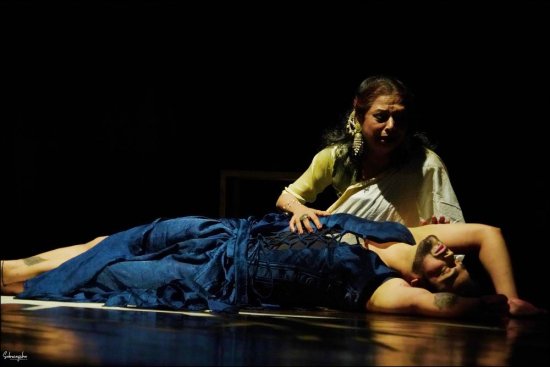 Liriope finds Narcissus dead The slick production staged at the Stein auditorium, India Habitat Centre on June 26, with powerful solo performances in Kathak blended with significant inputs from Ballet, Modern Dance, Bharatanatyam, not to speak of inspirations of Butoh and Theatre, left the audience in some kind of awe. After a hint of celebration capers through a Tarana in Hamsadhwani, the scene changes to Narcissus' mother, nymph Liriope, coming upon the dead Narcissus - remembering the past, when carrying baby Narcissus in her arms and seeking blessings from the Gods, she is told by the seer Tiresias, a blind prophet of Apollo in Thebes, that Narcissus will live as long as he does not recognize himself. 'Why this cruelty,' Liriope sobs in agony, when her child is the product of being physically assaulted, and forced upon, by the river God? The scene quickly changes to Narcissus' early years of growing up, being educated and trained by the mother to ride a horse, to excel in archery, and what have you - with the boy unaware of his unfathomable beauty. Meanwhile Echo (thanks to her extreme garrulousness and non-stop talking, which succeeds in tricking Juno into believing that husband Jupiter was in the city, which is not part of the plot performed) has been cursed, that she will never be able to initiate a sentence, but only finish one started by somebody else, as an echo. Spying the beauteous Narcissus, who has lost his way in the forest, Echo loses her heart to him and tries to follow him and throw her arms round him. Unable to voice her love, and rejected by Narcissus, she wastes away in heartbreak. 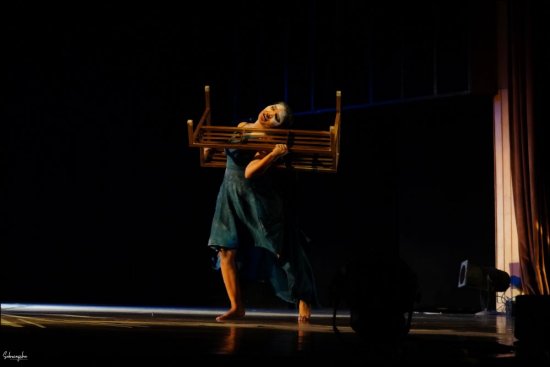 Echo carrying the shame and rejection imposed by society Comely young man Ameinias falls for the beautiful Narcissus, but after a short reprieve, is similarly spurned, and he kills himself. Through a quirk of circumstances, wandering in the forest, chancing to look at his own reflection, which he does not recognize, in the still waters of river Lamos, Narcissus falls deeply in love with the image he sees. Unable to reach it, even as it seems to reciprocate his every gesture, it finally dawns on him in shock, that he is looking at himself - which recognition spells his own tragic end as he drowns while trying to reach out to the image. Sudip seems adept at bringing together under one thematic umbrella, disparate elements like a Greek story and body languages, traditional and modern, from India and the west, including Butoh and theatre inspirations. The way Sudip in the role of Narcissus, harnesses Kathak ad-forms in unique situations shows how, what one considers as traditional nritta technique, can be imaginatively used to evoke a mood. Mansi Kumari, a Contemporary Dance specialist through her performance and actions ending carrying a steel frame through labored moments, successfully conveyed the frustrations of Echo, unable to voice her love. 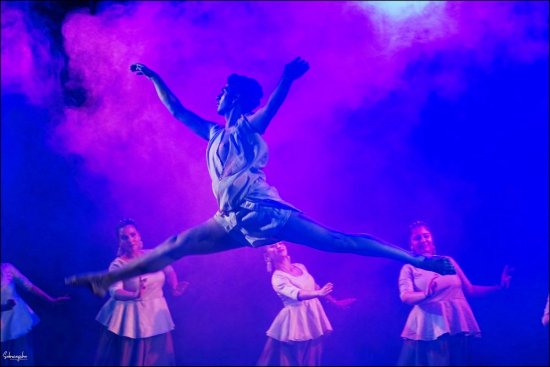 Ameinias leaps to find his position in society As the lovely young man Ameinias, Deepanshu Tyagi, in fluid movements surprised one and all with his prowess in Ballet and the short scene between him and Narcissus, for this critic, was one of the most skillfully executed, evocative scenes, between two male dancers - leading later to rejection of impassioned Ameinias' advances. Ambali Praharaj in her short appearances as the mother, showed herself to be a strong actor. The disciplined group scenes providing a kind of backdrop to actions which follow, in what was a fast moving production, had Jaydeep Sinha, Dhuva Mukherjee, Rakesh Chaudhuri, Rittick Chakraborty, Soumik Guha, and Amitangshu Brahma. In tune with Sudip's penchant for working with different types of body movement, is his feel for script which, apart from rhythmic syllables from Kathak, included short sentences from many languages - English, Hindi, Urdu, soulful Bengali and what have you, the music arrangement, keeping pace with a similar approach, in a mix of different styles. Starting with plaintive flute notes of a Bengali folk composition "kopaler pher noile ki aar…khchar bhitor ochin pakhi" in raga Desh, Hindustani, even Carnatic notes follow (one gets in the Bharatanatyam flash, a bit of Bilahari in the Pallavi swaras of the composition Raravenugopa bala, fitting in so well with the mood). Flashes of quick solo Kathak were performed to a Tarana and to raga Bageshri. Narcissus in the jungle wandering to Pilu Barwa strains and (according to information on details of music and sahitya of poetry, supplied by the dancer himself) the ballet sequence was performed to a section of Serenade of Legendary Ruggero Leoncavallo played in harp and cello by Alexander Boldachev, Lev Sikov - which work was recorded at the Studio Ananta in Kolkata by Bhabesh Modak. The final moments with Echo obsessed by his own image reflected in the water, rendered to very apt words in the Ghazal "Aine se kab talaq tum apne dil behlaoge" in raga Darbari to the soulful end with words of Tagore in raga Bhairavi "Pipasha hay nahi mitilo", concluded with the curtain call "gulo mey rang" in Jhinjhoti. Even today the obsession with oneself plagues human beings. Sudip's fertile creativity, if pursued without footfalls, seems to hold prospects of an exciting future! 'AND SHE SPOKE' LEAVES AUDIENCE SPEECHLESS Photos: Vinay Tiwari It was very fitting that for an occasion remembering an independent minded woman like late Madhavi Gopalakrishnan, a work like 'And She Spoke' on the voices of women in a deep rooted patriarchal society, should be presented at the IIC, Delhi. One of the trustees, daughter Meera Khanna, in her introductory remarks hit the nail on the head with the statement of her as "a mother who taught us to never be dependent on her" while her sibling, dancer Rama Vaidyanathan, has on several occasions referred to her own mental stamina in facing up to career ruffles, as a result of the strength drawn from her mother.  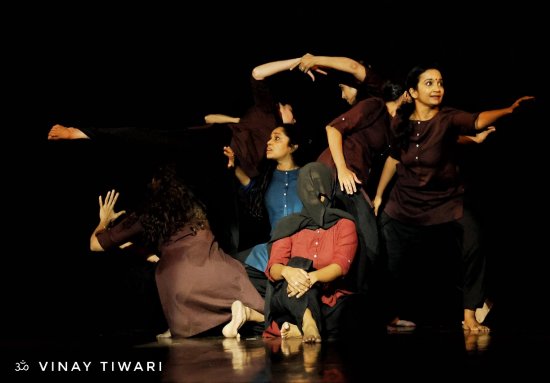 For a dance theatre venture like And She Spoke, one cannot have a better director than Vaibhav Arekar, whose specialization in Bharatanatyam is spiced with considerable theatre experience. And the production designing comes from Sushant Jhadav. Doing away with scripted versions, here is a production totally built on voices of the lived-in and shared experiences of women. In our patriarchal society, woman has been given allotted only one status - that of anonymity. Woman's role even in the home is to be felt and not seen. The more we exult in enacting and watching scenes of Dushasana's blood being anointed on Draupadi's hair, the more cases one seems to hear of women being shamed in different parts of the country by being disrobed and paraded. While politicians generously sanction free bus rides for women, can they as strongly endorse dignified travel in the bus and trains for them, without being pawed by male passengers standing behind them? Brutalized, even murdered by lawfully wedded husband and living mates, down-trodden woman after the "Me too' episode, at least seem to have found a voice to voice grievances. One does not need explanations for what is enacted in And She Spoke, for movements and actions speak loud enough. As Vaibhav said in the after performance exchange, the Sitas and Rukminis, and Nayikas of dance are wonderful to present and they certainly have their artistic value. But after the pandemic incarceration, he was gripped by an uneasiness with a feeling that something which reverberated with life as lived now, had to be shown in dance. One cannot forget that great women saint poets like Lal Ded, Janabai, Muktabai, Bahinabai, Andal and many more, were firstly fearless women. And silence will not help. Wounded womanhood in a huddle has to speak out loud and tell society that no freedom is worth its salt, unless woman is respected and shares equal rights with man. At home where she is the drudge, on the streets where 'eyes of men crawl like larvae over her body' (thottu, thottu pesa varaan), at work putting up with the boss's unwelcome advances, stalked, raped, and left to fend for herself, what is the space given to women in the country? 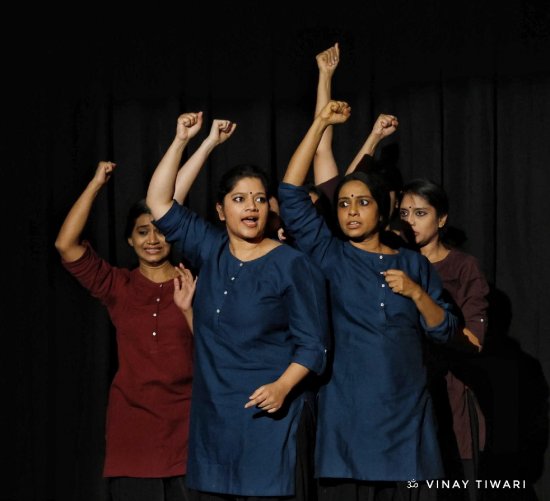 Beautifully enacted, the movement imagery, even when derived from Bharatanatyam opts for a natural feel, and actions showing a 'silent scream' speak louder than words. Snatches of known songs, whispered words, silence, actions all add up to a powerful blend. And one sees woman struggling to accommodate both job and bringing up a child and several such acts, all show that the fight for dignity and equality is not over. The entire experience for the participants must have been cathartic, for some scenes relate to what some of the actors actually went through. The tumultuous applause after the performance spoke volumes. Thrown open to the audience for questioning, one was hoping for some reactions from males. They seemed to have been left speechless! This critic suggested that the performance should be taken to colleges across the country. Vaibhav remarked, "We are willing but get us the sponsorship to cover the expenses involved." SPICMACAY should take up this kind of a show. One fails to understand the logic of restricting all participation in SPICMACAY programs only to award winners! So much that is worthwhile and happening outside the periphery of awardees, is missed. Surely by now some of those connected with these programs from the start, should have acquired enough knowhow to judge from what is happening all round in the culture field! Altogether a fortnight to remember!  Writing on the dance scene for the last forty years, Leela Venkataraman's incisive comments on performances of all dance forms, participation in dance discussions both in India and abroad, and as a regular contributor to Hindu Friday Review, journals like Sruti and Nartanam, makes her voice respected for its balanced critiquing. She is the author of several books like Indian Classical dance: Tradition in Transition, Classical Dance in India and Indian Classical dance: The Renaissance and Beyond. Post your comments Pl provide your name and email id along with your comment. All appropriate comments posted with name and email id in the blog will also be featured in the site. |